Freely Available British and Irish Public Legal Information
[Home] [Databases] [World Law] [Multidatabase Search] [Help] [Feedback]
Statutory Instruments of the Scottish Parliament
You are here: BAILII >> Databases >> Statutory Instruments of the Scottish Parliament >> Act of Sederunt (Ordinary Cause Rules Amendment) (Personal Injuries Actions) 2009 No. 285
URL: http://www.bailii.org/scot/legis/num_reg/2009/ssi_20090285_en_1.html
[New search] [Help]
Act of Sederunt (Ordinary Cause Rules Amendment) (Personal Injuries Actions) 2009
Made
24th July 2009
Coming into force
2nd November 2009
The Lords of Council and Session, under and by virtue of the powers conferred by section 32 of the Sheriff Courts (Scotland) Act 1971(1), and of all other powers enabling them in that behalf, having approved draft rules submitted to them by the Sheriff Court Rules Council in accordance with section 34 of the said Act of 1971, do hereby enact and declare:
Citation, commencement and interpretation
1.–(1) This Act of Sederunt may be cited as the Act of Sederunt (Ordinary Cause Rules Amendment) (Personal Injuries Actions) 2009 and comes into force on 2nd November 2009.
(2) This Act of Sederunt is to be inserted in the Books of Sederunt.
(3) In this Act of Sederunt, "the Ordinary Cause Rules" means the Ordinary Cause Rules in Schedule 1 to the Sheriff Courts (Scotland) Act 1907(2).
Amendment of Ordinary Cause Rules: personal injuries actions
2.–(1) The Ordinary Cause Rules are amended in accordance with subparagraphs (2) to (10).
(2) In rule 3.1 (form of initial writ), after paragraph (1)(b)(3) insert–
"or
(c) in the case of a personal injuries action within the meaning of Part AI of Chapter 36, by initial writ in Form PI1.".
(3) In rule 13.1 (person claiming title and interest to enter process as a defender), in paragraph (4), after "record" insert "or in a personal injuries action subject to personal injuries procedure after the date upon which the record is required to be lodged".
(4) In rule 13.2 (procedure following leave to enter process)(4), after paragraph (3) insert–
"(4) Paragraphs (1), (2) and (3) shall not apply to a personal injuries action which is subject to personal injuries procedure.
(5) Where the sheriff grants an application under rule 13.1 in a personal injuries action which is subject to personal injuries procedure, the sheriff may make such further order as he thinks fit.".
(5) In rule 21.1 (lodging documents founded on or adopted), in paragraph (1)(a), after "rule 9.3" insert "or, in the case of a personal injuries action raised under Part AI of Chapter 36, when the initial writ is presented for warranting in accordance with rule 5.1".
(6) In Chapter 36 (actions of damages), before Part 1 (intimation to connected persons in certain actions of damages) insert–
"PART AI SPECIAL PROCEDURE FOR ACTIONS FOR, OR ARISING FROM, PERSONAL INJURIES
Application and interpretation
Application and interpretation of this Part
36.A1.–(1) This Part applies to a personal injuries action.
(2) In this Part–
"personal injuries action" means an action of damages for, or arising from, personal injuries or death of a person from personal injuries; and
"personal injuries procedure" means the procedure established by rules 36.G1 to 36.L1.
(3) In the definition of "personal injuries action", "personal injuries" includes any disease or impairment, whether physical or mental.
Raising a personal injuries action
Form of initial writ
36.B1.–(1) Subject to rule 36.C1, the initial writ in a personal injuries action shall be in Form PI1 and there shall be annexed to it a brief statement containing–
(a) averments in numbered paragraphs relating only to those facts necessary to establish the claim;
(b) the names of every medical practitioner from whom, and every hospital or other institution in which, the pursuer or, in an action in respect of the death of a person, the deceased received treatment for the personal injuries.
(2) An initial writ may include–
(a) warrants for intimation so far as permitted under these Rules, and
(b) a specification of documents in Form PI2.
Actions based on clinical negligence
36.C1.–(1) An initial writ in a personal injuries action may include a draft interlocutor in Form PI4.
(2) At the same time as an initial writ which includes a draft interlocutor in Form PI4 is presented for warranting, the pursuer may lodge a written application in the form of a letter addressed to the sheriff clerk for authority to raise the action, where it is based on alleged clinical negligence, as an ordinary cause.
(3) On the making of an application under paragraph (2), the initial writ shall be placed before a sheriff in chambers and in the absence of the parties.
(4) On consideration of the initial writ in accordance with paragraph (3), the sheriff may–
(a) if he considers that there are exceptional reasons for not following personal injuries procedure such as would justify the granting of a motion under rule 36.F1, grant authority for the cause to proceed as an ordinary cause by signing the draft interlocutor in the initial writ; or
(b) fix a hearing.
(5) The sheriff clerk shall notify the parties of the date and time of any hearing under paragraph (4)(b).
(6) At a hearing under paragraph (4)(b), the sheriff may refuse the application or, if he considers that there are exceptional reasons for not following personal injuries procedure such as would justify the granting of a motion under rule 36.F1, grant authority for the cause to proceed as an ordinary cause by signing the draft interlocutor in the initial writ.
(7) Where the sheriff grants authority for the cause to proceed as an ordinary cause under paragraph (4)(a) or (6)–
(a) the sheriff or, as the case may be, the sheriff clerk shall sign a warrant in accordance with rule 5.1 (signature of warrants)(5);
(b) the cause shall thereafter proceed in accordance with Chapter 9 (standard procedure in defended causes) rather than in accordance with personal injuries procedure.
(8) In this rule–
"clinical negligence" means a breach of a duty of care by a health care professional in connection with that person´s diagnosis or the care and treatment of any person, by act or omission, whilst the health care professional was acting in his professional capacity; and
"health care professional" includes a doctor, dentist, nurse, midwife, health visitor, pharmacy practitioner, registered ophthalmic practitioner, registered dispensing optician, member of Professions Allied to Medicine, member of the Allied Health Professions, a person who is a member of ambulance personnel, a member of laboratory staff or a relevant technician.
Inspection and recovery of documents
36.D1.–(1) This rule applies where the initial writ in a personal injuries action contains a specification of documents by virtue of rule 36.B1(2)(b).
(2) On the granting of a warrant for citation, an order granting commission and diligence for the production and recovery of the documents mentioned in the specification shall be deemed to have been granted and the sheriff clerk shall certify Form PI2 to that effect by attaching thereto a docquet in Form PI3.
(3) An order which is deemed to have been made under paragraph (2) shall be treated for all purposes as an interlocutor granting commission and diligence signed by the sheriff.
(4) The pursuer may serve an order under paragraph (2) and the provisions of Chapter 28 (recovery of evidence) shall thereafter apply, subject to any necessary modifications, as if the order were an order obtained on an application under rule 28.2 (applications for commission and diligence for recovery of documents etc.)(6).
(5) Nothing in this rule shall affect the right of a party to apply under rule 28.2 for a commission and diligence for recovery of documents or for an order under section 1 of the Administration of Justice (Scotland) Act 1972(7) in respect of any document or other property whether or not mentioned in the specification annexed to the initial writ.
Personal injuries action: application of other rules and withdrawal from personal injuries procedure
Application of other rules
36.E1.–(1) Subject to rule 36.F1, a defended personal injuries action shall, instead of proceeding in accordance with Chapter 9 (standard procedure in defended causes), proceed in accordance with personal injuries procedure.
(2) Paragraph (1) does not apply to a personal injuries action in respect of which the sheriff has granted an application under rule 36.C1(2).
(3) Paragraphs (4) to (14) apply to a personal injuries action proceeding in accordance with personal injuries procedure.
(4) Despite paragraph (1), the following rules of Chapter 9 apply–
(a) rule 9.1 (notice of intention to defend)(8);
(b) rule 9.3 (return of initial writ);
(c) rule 9.5 (process folder);
(d) rule 9.6 (defences)(9); and
(e) rule 9.7 (implied admissions).
(5) But the defences shall not include a note of pleas-in-law.
(6) In the application of rule 18.3(1) (applications to amend), a minute of amendment lodged in process shall include, where appropriate, confirmation as to whether any warrants are sought under rule 36.B1(2)(a) or whether a specification of documents is sought under rule 36.B1(2)(b).
(7) In the application of rule 18.5(1)(a) (service of amended pleadings)(10), the sheriff shall order any timetable issued in terms of rule 36.G1 to be served together with a copy of the initial writ or record.
(8) Rule 18.5(3) (fixing of hearing following service of amended pleadings and lodging of notice of intention to defend) shall not apply.
(9) In the application of rule 19.1 (counterclaims)(11) a counterclaim may also include–
(a) warrants for intimation so far as permitted under these Rules; and
(b) a specification of documents in Form PI2.
(10) In rule 19.4 (disposal of counterclaims), paragraph (b) shall not apply.
(11) In the application of rule 20.4(3) (service on third party(12)), any timetable already issued in terms of rule 36.G1 shall also be served with a third party notice.
(12) In the application of rule 20.6 (procedure following answers)–
(a) paragraphs (1) and (2) shall not apply; and
(b) where a third party lodges answers, any timetable already issued under rule 36.G1 shall apply to the third party.
(13) Chapters 22 (preliminary pleas) and 28A (pre-proof hearing)(13) shall not apply.
(14) In relation to an action proceeding in accordance with personal injuries procedure–
(a) references elsewhere in these Rules to the condescendence of an initial writ or to the articles of the condescendence shall be construed as references to the statement required under rule 36.B1(1) and the numbered paragraphs of that statement;
(b) references elsewhere in these Rules to pleas-in-law, an open record, a closed record or a record for an Options Hearing shall be ignored;
(c) references elsewhere in these Rules to any action carried out before or after the closing of the record shall be construed as references to that action being carried out before, or as the case may be, after, the date fixed for completion of adjustment under rule 36.G1(1)(b)(iii).
Disapplication of personal injuries procedure
36.F1.–(1) Any party to a personal injuries action proceeding in accordance with personal injuries procedure may, within 28 days of the lodging of defences (or, where there is more than one defender the first lodging of defences), by motion apply to have the action withdrawn from personal injuries procedure and to be appointed to proceed as an ordinary cause.
(2) No motion under paragraph (1) shall be granted unless the sheriff is satisfied that there are exceptional reasons for not following personal injuries procedure.
(3) In determining whether there are exceptional reasons justifying the granting of a motion made under paragraph (1), the sheriff shall have regard to–
(a) the likely need for detailed pleadings;
(b) the length of time required for preparation of the action; and
(c) any other relevant circumstances.
(4) Where the sheriff appoints the cause to proceed as an ordinary cause under paragraph (1)–
(a) the sheriff clerk shall fix a date and time for an Options Hearing;
(b) the cause shall thereafter proceed in accordance with Chapter 9 rather than in accordance with personal injuries procedure;
(c) the pursuer shall within 14 days thereof lodge a revised initial writ as nearly as may be in Form G1; and
(d) the defender shall thereafter adjust his defences so as to comply with rule 9.6(2).
Personal injuries procedure
Allocation of diets and timetables
36.G1.–(1) The sheriff clerk shall, on the lodging of defences in the action or, where there is more than one defender, the first lodging of defences–
(a) allocate a diet for proof of the action, which shall be no later than 9 months from the date of the first lodging of defences; and
(b) issue a timetable stating the date mentioned in subparagraph (a) and calculated by reference to periods specified in Appendix 3, which, with the exception of the period specified in rule 36.K1(2), the sheriff principal may vary for his sheriffdom or for any court within his sheriffdom, within which–
(i) an application for a third party notice under rule 20.1 may be made;
(ii) the pursuer may execute a commission for recovery of documents under rule 36.D1;
(iii) parties may adjust their pleadings;
(iv) the pursuer shall lodge a statement of valuation of claim in process;
(v) the pursuer shall lodge a record;
(vi) the defender (and any third party to the action) shall lodge a statement of valuation of claim in process;
(vii) the parties shall each lodge in process a list of witnesses together with any productions upon which they wish to rely; and
(viii) the pursuer shall lodge in process the minute of the pre-proof conference.
(2) A timetable issued under paragraph (1)(b) shall be in Form PI5 and shall be treated for all purposes as an interlocutor signed by the sheriff; and so far as the timetable is inconsistent with any provision in these Rules which relates to a matter to which the timetable relates, the timetable shall prevail.
(3) Where a party fails to comply with any requirement of a timetable other than that referred to in paragraph (8) or rule 36.K1(3), the sheriff clerk may fix a date and time for the parties to be heard by the sheriff.
(4) The pursuer shall lodge a certified copy of the record, which shall consist of the pleadings of the parties, in process by the date specified in the timetable and shall at the same time send one copy to the defender and any other parties.
(5) The pursuer shall, on lodging the certified copy of the record as required by paragraph (4), apply by motion to the sheriff, craving the court–
(a) to allow to parties a preliminary proof on specified matters;
(b) to allow a proof; or
(c) to make some other specified order.
(6) The motion lodged under paragraph (5) shall specify the anticipated length of the preliminary proof, or proof, as the case may be.
(7) In the event that any party proposes to crave the court to make any order other than an order allowing a proof under paragraph (5)(b), that party shall, on making or opposing (as the case may be) the pursuer´s motion, specify the order to be sought and give full notice in the motion or the notice of opposition thereto of the grounds thereof.
(8) Where the pursuer fails to lodge a record by the date specified in the timetable issued under paragraph (1), the sheriff clerk shall fix a date and time for the parties to be heard by the sheriff.
(9) A production which is not lodged in accordance with paragraph (1)(b)(vii) shall not be used or put in evidence at proof unless–
(a) by consent of parties; or
(b) with the leave of the sheriff on cause shown and on such conditions, if any, as to expenses or otherwise as the court thinks fit.
(10) In a cause which is one of a number of causes arising out of the same cause of action, the sheriff may–
(a) on the motion of a party to that cause; and
(b) after hearing parties to all those causes,
appoint that cause or any part of those causes to be the leading cause and to sist the other causes pending the determination of the leading cause.
(11) In this rule, "pursuer" includes additional pursuer or minuter as the case may be.
Applications for sist or for variation of timetable
36.H1.–(1) The action may be sisted or the timetable varied by the sheriff on an application by any party to the action by motion or following the amendment of pleadings carried out under Chapter 18.
(2) An application under paragraph (1)–
(a) shall be placed before the sheriff; and
(b) shall be granted only on special cause shown.
(3) Any sist of an action in terms of this rule shall be for a specific period.
(4) Where the timetable issued under rule 36.G1 is varied under this rule, the sheriff clerk shall issue a revised timetable in Form PI5.
(5) A revised timetable issued under paragraph (4) shall have effect as if it were a timetable issued under rule 36.G1 and any reference in this Part to any action being taken in accordance with the timetable shall be construed as a reference to its being taken in accordance with the timetable as varied under this rule.
Statements of valuation of claim
36.J1.–(1) Each party to the action shall make a statement of valuation of claim in Form PI6.
(2) A statement of valuation of claim (which shall include a list of supporting documents) shall be lodged in process.
(3) Each party shall, on lodging a statement of valuation of claim–
(a) intimate the list of documents included in the statement of valuation of claim to every other party; and
(b) lodge each of those documents.
(4) Nothing in paragraph (3) shall affect–
(a) the law relating to, or the right of a party to object to, the recovery of a document on the ground of privilege or confidentiality; or
(b) the right of a party to apply under rule 28.2(14) for a commission and diligence for recovery of documents or an order under section 1 of the Administration of Justice (Scotland) Act 1972(15).
(5) Without prejudice to paragraph (2) of rule 36.L1, where a party has failed to lodge a statement of valuation of claim in accordance with a timetable issued under rule 36.G1, the sheriff may, at any hearing under paragraph (3) of that rule–
(a) where the party in default is the pursuer, dismiss the action; or
(b) where the party in default is the defender, grant decree against the defender for an amount not exceeding the pursuer´s valuation.
Pre-proof conferences
36.K1.–(1) For the purposes of this rule, a pre-proof conference is a conference of the parties, which shall be held not later than four weeks before the date assigned for the proof–
(a) to discuss settlement of the action; and
(b) to agree, so far as is possible, the matters which are not in dispute between them.
(2) Subject to any variation of the timetable in terms of rule 36.H1, a joint minute of a pre-proof conference, made in Form PI7, shall be lodged in process by the pursuer not later than three weeks before the date assigned for proof.
(3) Where a joint minute in Form PI7 has not been lodged in accordance with paragraph (2) and by the date specified in the timetable the sheriff clerk shall fix a date and time for the parties to be heard by the sheriff.
(4) During the pre-proof conference, the representative of each party to the action shall have access to the party or another person who has authority to commit the party in settlement of the action.
Incidental hearings
36.L1.–(1) Where the sheriff clerk fixes a date and time for a hearing under paragraph (3) or (8) of rule 36.G1 or paragraph (3) of rule 36.K1 he shall–
(a) fix a date not less than seven days after the date of the notice referred to in subparagraph (b);
(b) give notice to the parties to the action–
(i) of the date and time of the hearing; and
(ii) requiring the party in default to lodge in process a written explanation as to why the timetable has not been complied with and to intimate a copy to all other parties, not less than two clear working days before the date of the hearing.
(2) At the hearing, the sheriff–
(a) shall consider any explanation provided by the party in default;
(b) may award expenses against that party; and
(c) may make any other appropriate order, including decree of dismissal.".
(7) In Chapter 36, after Part V (Sex Discrimination Act 1975) insert–
"PART VI MESOTHELIOMA ACTIONS: SPECIAL PROVISIONS
Mesothelioma actions: special provisions
36.19.–(1) This Part applies where liability to a relative of the pursuer may arise under section 1(2A) and (2B) of the Damages (Scotland) Act 1976 (liability where the personal injury in consequence of which the deceased died is mesothelioma)(16).
(2) On settlement of the pursuer´s claim, the pursuer may apply by motion for all or any of the following–
(a) a sist for a specified period;
(b) discharge of any diet;
(c) where the action is one to which the personal injuries procedure in Part A1 of this Chapter applies, variation of the timetable issued under rule 36.G1.
(3) Paragraphs (4) to (7) apply where a motion under paragraph (2) has been granted.
(4) As soon as reasonably practicable after the death of the pursuer, any agent who immediately prior to the death was instructed in a cause by the deceased pursuer shall notify the court of the death.
(5) The notification under paragraph (4) shall be by letter to the sheriff clerk and shall be accompanied by a certified copy of the death certificate relative to the deceased pursuer.
(6) A relative of the deceased may apply by motion for the recall of the sist and for an order for further procedure.
(7) On expiration of the period of any sist pronounced on a motion under paragraph (2), the sheriff clerk may fix a date and time for the parties to be heard by the sheriff.".
(8) In rule 36.17A (productions in certain actions of damages), after "injuries", where it secondly occurs, insert ", which, by virtue of rule 36.C1 or rule 36.F1, is to proceed as an ordinary cause".
(9) In Appendix 1 to the Ordinary Cause Rules, after Form M6 insert the forms set out in Schedule 1 to this Act of Sederunt.
(10) After Appendix 2 to the Ordinary Cause Rules insert Appendix 3 set out in Schedule 2 to this Act of Sederunt.
Transitional and saving provision
3. Paragraph 2 of this Act of Sederunt shall not apply to an action raised before 2nd November 2009.
A.C. HAMILTON
Lord President
I.P.D.
Edinburgh
24th July 2009
Paragraph 2(9)
SCHEDULE 1
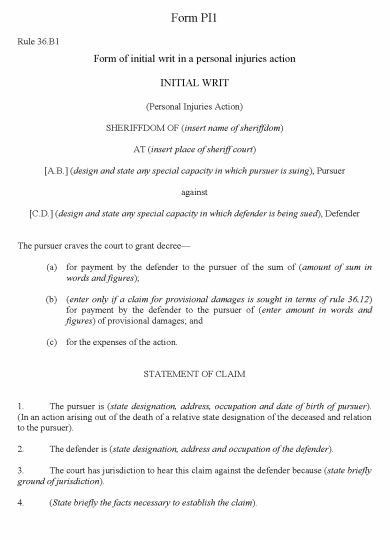
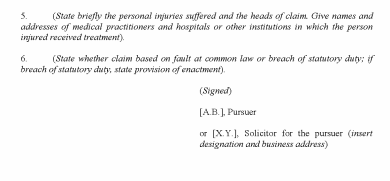
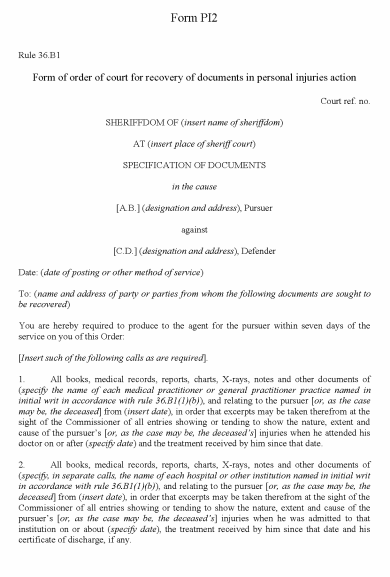
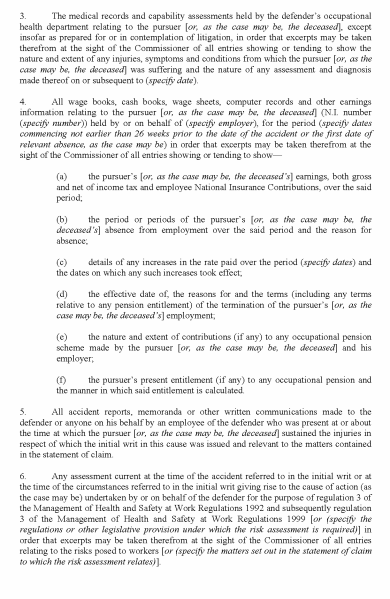
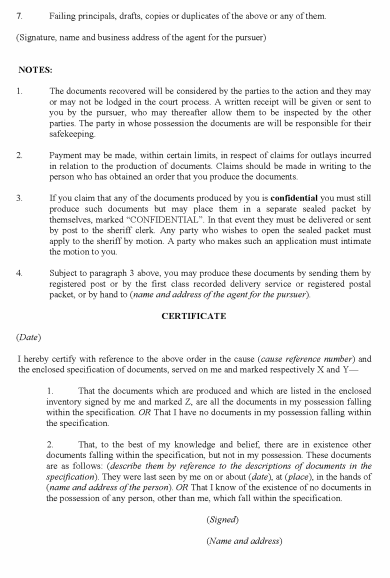
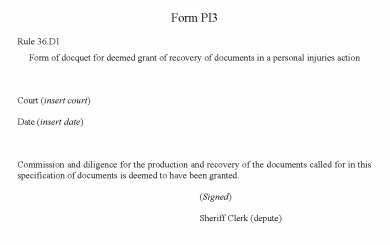
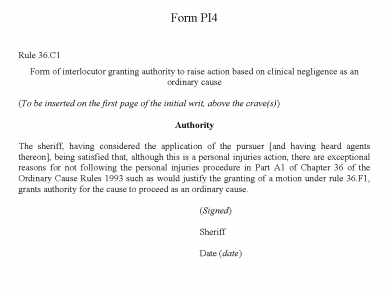
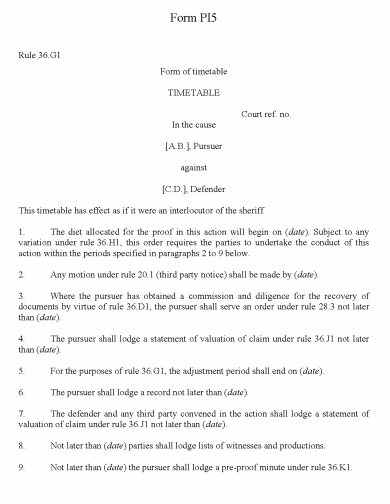

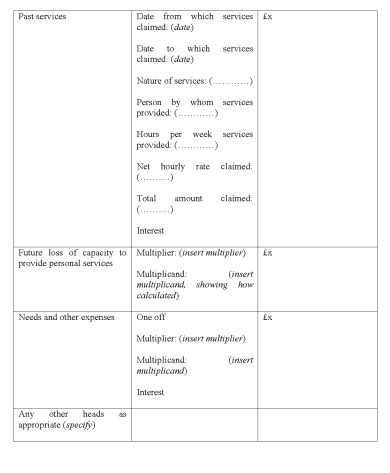
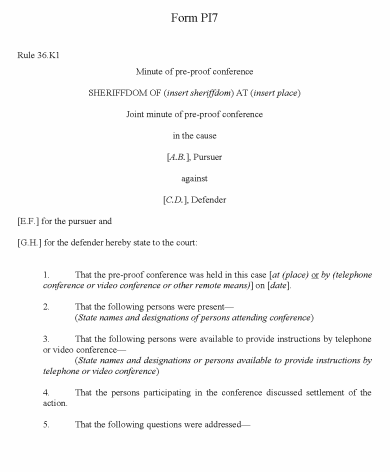
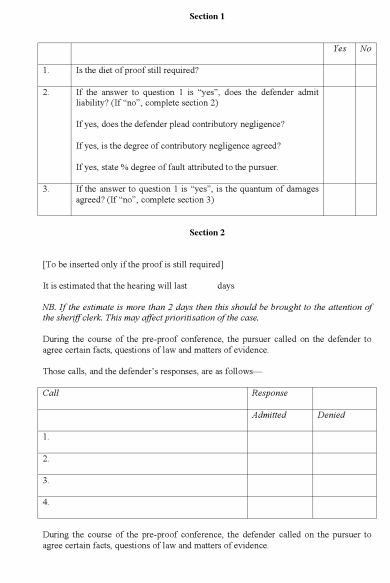
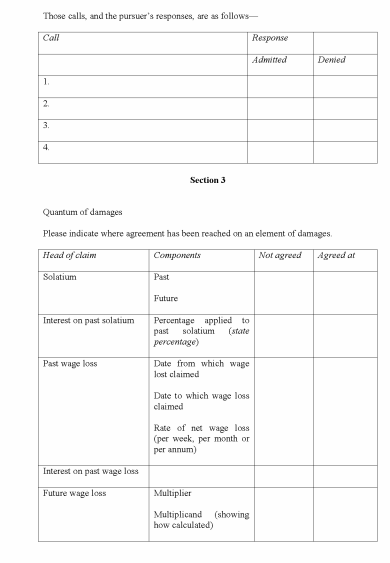
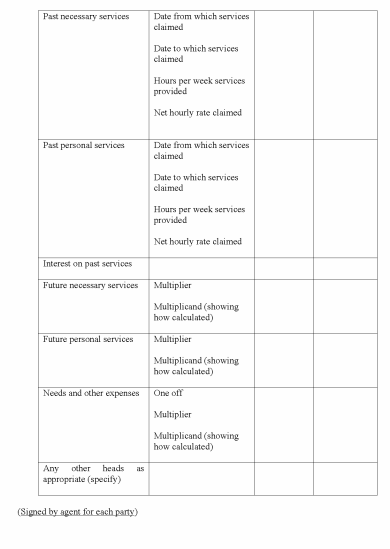
Paragraph 2(10)
SCHEDULE 2

EXPLANATORY NOTE
(This note is not part of the Act of Sederunt)
This Act of Sederunt amends the rules of procedure in the sheriff court to make additional provision in Chapter 36 of the Sheriff Court Ordinary Cause Rules 1993 (the Rules) setting out a special procedure for actions for, or arising out of, personal injuries. The special procedure is referred to as personal injuries procedure, and will be applicable to actions of damages for, or arising from, personal injuries or death of a person from personal injuries raised from 2nd November 2009. Personal injuries actions raised prior to that date will continue to be dealt with under the existing rules in Chapter 36 of the Rules.
Paragraph 2 amends the Rules in consequence of the introduction of personal injuries procedure.
Paragraph 2(2) amends rule 3.1 of the Rules to refer to a new form of initial writ to be used under personal injuries procedure.
Paragraph 2(3) amends rule 13.1 of the Rules to make provision on the applicable procedure for entering process as a defender in circumstances where an action has been raised under personal injuries procedure.
Paragraph 2(4) disapplies rule 13.2 of the Rules, which relates to the procedure applicable once leave to enter the process has been granted, where an action is subject to personal injuries procedure. Where an action proceeds under this procedure, provision is made for the sheriff to grant such further order as he sees fit.
Paragraph 2(5) amends rule 21.1 of the Rules to provide that where an action is raised under personal injuries procedure, any documents to be founded upon or adopted require to be lodged when the initial writ is first presented for warranting.
Paragraph 2(6) inserts a new Part AI into Chapter 36 of the Rules, setting out the special procedure for actions relating to personal injuries.
Inserted rule 36.A1 sets out the application and interpretation of the provisions in Part AI of Chapter 36 of the Rules.
Inserted rule 36.B1 and Forms PI1 and PI2 in Schedule 1 make provision as to the form of initial writ and any specification of documents where a personal injuries action is raised.
Inserted rule 36.C1 provides for an exception to following personal injuries procedure in circumstances where an action is based on alleged clinical negligence. In those circumstances, rule 36.C1 allows the sheriff to grant authority for the cause to proceed as an ordinary cause, and makes provision for further procedure.
Inserted rule 36.D1 provides that where an initial writ in a personal injuries action contains a specification of documents, an order granting commission and diligence for the production and recovery of documents shall be deemed to be granted upon a warrant for citation being granted. It also provides for further procedure thereafter.
Inserted rule 36.E1 provides for the application (with or without modification) or non-application of various rules in relation to a defended personal injuries action.
Inserted rule 36.F1 makes provision for any party to a personal injuries action to apply to the sheriff to have the action withdrawn from the personal injuries procedure and to be appointed to proceed instead as an ordinary cause. The rule makes provision as to the factors upon which the sheriff must be satisfied in order to grant such an application and makes provision regarding further procedure where the application is granted.
Inserted rule 36.G1, Form PI5 in Schedule 1 and Schedule 2 all make provision in relation to the allocation of diets and the issuing of timetables under personal injuries procedure.
Inserted rule 36.H1 makes provision regarding applications to the sheriff for sist or for variation of the timetable by any party to an action which is subject to personal injuries procedure.
Inserted rule 36.J1 and Form PI6 in Schedule 1 make provision requiring each party to a personal injuries action to lodge a statement of valuation of claim in process. Rule 36.J1 also makes further related provision.
Inserted rule 36.K1 requires the parties to a personal injuries action to hold a pre-proof conference not later than 4 weeks before the date assigned for proof, to discuss settlement of the action and to agree, so far as is possible, the matters which are not in dispute between them. The rule also requires the parties to lodge a joint minute of the pre-proof conference, in Form PI7 in Schedule 1, in process not later than 3 weeks before the date assigned for proof. The timescale for lodging the joint minute is subject to any variation of the timetable in terms of rule 36.H1.
Inserted rule 36.L1 makes provision for the procedure applicable in relation to the fixing of incidental hearings under rules 36.G1 or 36.K1 by the sheriff clerk.
Paragraph 2(7) inserts a new Part VI into Chapter 36 of the Rules, including rule 36.19. This new Part and new rule make special provision in relation to actions raised where liability to a relative of a pursuer may arise under section 1(2A) and (2B) of the Damages (Scotland) Act 1976 where death of a person has occurred due to mesothelioma.
Paragraph 2(8) amends rule 36.17A, which relates to the lodging of productions in certain actions of damages, so as to make provision for the new routes by which a personal injuries action can proceed as an ordinary action under rules 36.C1 or 36.F1.
Paragraph 2(9) amends Appendix 1 to the Rules by inserting into that Appendix the forms PI1 to PI7, set out in Schedule 1 to this instrument.
Paragraph 2(10) inserts a new Appendix 3 into the Rules, as set out at Schedule 2 to this instrument. This is the Schedule of the timetable under the personal injuries procedure.
1971 c.58. Section 32 was amended by the Law Reform (Miscellaneous Provisions) (Scotland) Act 1985 (c.73), Schedule 2, paragraph 12, the Civil Evidence (Scotland) Act 1988 (c.32), section 2(4), the Children (Scotland) Act 1995 (c.36), Schedule 4, paragraph 18(2), the Adults with Incapacity (Scotland) Act 2000 (asp 4), schedule 5, paragraph 13 and the Debt Arrangement and Attachment (Scotland) Act 2002 (asp 17), section 43 and the Vulnerable Witnesses (Scotland) Act 2004 (asp 3), section 14(2) and was extended by the Child Support Act 1991 (c.48), sections 39(2) and 49 and the Bankruptcy and Diligence (Scotland) Act 2007 (asp 3), section 33. Back [1]
1907 c.51. Schedule 1 was substituted by S.I. 1993/1956 and amended by S.I. 1996/2167 and 2445, S.S.I. 2000/239 and 408, 2001/8 and 144, 2002/7, 128 and 560, 2003/25 and 26, 2004/197 and 350, 2005/20, 189, 638 and 648, 2006/198, 207, 293, 410 and 509, 2007/6, 339, 440 and 463, 2008/121, 223 and 365 and 2009/107, 164 and 284. Back [2]
Rule 3.1(1) was substituted by S.S.I. 2001/8. Back [3]
Rule 13.2 was amended by S.I. 1996/2445. Back [4]
Rule 5.1 was amended by S.S.I. 2004/197 and 2006/207. Back [5]
Rule 28.2 was amended by S.I. 1996/2445 and S.S.I. 2007/6. Back [6]
1972 c.59, Section 1 was amended by section 19 of, and paragraph 15 of Schedule 2 to, the Law Reform (Miscellaneous Provisions) (Scotland) Act 1985 (c.73). Back [7]
Rule 9.1 was amended by S.I. 1996/2167 and S.S.I. 2001/8 and 2006/207. Back [8]
Rule 9.6 was amended by S.I. 1996/2167 and S.S.I. 2006/207. Back [9]
Rule 18.5(1) was amended by S.I. 1996/2167 and S.S.I. 2007/6. Back [10]
Rule 19.1 was amended by S.S.I. 2006/207. Back [11]
Rule 20.4(3) was amended by S.S.I. 2003/26. Back [12]
Chapter 28A was inserted by S.S.I. 2006/410. Back [13]
Rule 28.2 was amended by S.I. 1996/2445 and S.S.I. 2007/6. Back [14]
1972 c.59. Section 1 was amended by section 19 of, and paragraph 15 of Schedule 2 to, the Law Reform (Miscellaneous Provisions) (Scotland) Act 1985 (c.73). Back [15]
1976 c.13. Paragraphs (2A) and (2B) of section 1 were inserted by section 1 of the Rights of Relatives to Damages (Mesothelioma) (Scotland) Act 2007 (asp 18). Back [16]
